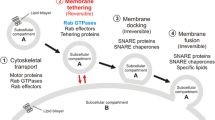Abstract
Oxysterol-binding protein (OSBP) and OSBP-related proteins (ORPs) are a conserved family of soluble cytoplasmic proteins that can bind sterols, translocate between membrane compartments, and affect sterol trafficking. These properties make ORPs attractive candidates for lipid transfer proteins (LTPs) that directly mediate nonvesicular sterol transfer to the plasma membrane. To test whether yeast ORPs (the Osh proteins) are sterol LTPs, we studied endoplasmic reticulum (ER)-to-plasma membrane (PM) sterol transport in OSH deletion mutants lacking one, several, or all Osh proteins. In conditional OSH mutants, ER-PM ergosterol transport slowed ~20-fold compared with cells expressing a full complement of Osh proteins. Although this initial finding suggested that Osh proteins act as sterol LTPs, the situation is far more complex. Osh proteins have established roles in Rho small GTPase signaling. Osh proteins reinforce cell polarization and they specifically affect the localization of proteins involved in polarized cell growth such as septins, and the GTPases Cdc42p, Rho1p, and Sec4p. In addition, Osh proteins are required for a specific pathway of polarized secretion to sites of membrane growth, suggesting that this is how Osh proteins affect Cdc42p- and Rho1p-dependent polarization. Our findings suggest that Osh proteins integrate sterol trafficking and sterol-dependent cell signaling with the control of cell polarization.

Similar content being viewed by others
Abbreviations
- ER:
-
Endoplasmic reticulum
- GFP:
-
Green-fluorescent protein
- LTP:
-
Lipid transfer protein
- ORP:
-
Oxysterol-binding protein related protein
- OSBP:
-
Oxysterol-binding protein
- PM:
-
Plasma membrane
References
Urbani L, Simoni RD (1990) Cholesterol and vesicular stomatitis virus G protein take separate routes from the endoplasmic reticulum to the plasma membrane. J Biol Chem 265:1919–1923
Baumann NA, Sullivan DP, Ohvo-Rekilä H et al (2005) Transport of newly synthesized sterol to the sterol-enriched plasma membrane occurs via nonvesicular equilibration. Biochemistry 44:5816–5826. doi:10.1021/bi048296z
Dawson PA, Van der Westhuyzen DR, Goldstein JL et al (1989) Purification of oxysterol binding protein from hamster liver cytosol. J Biol Chem 264:9046–9052
Schroepfer GJ Jr (2000) Oxysterols: modulators of cholesterol metabolism and other processes. Physiol Rev 80:361–554
Kandutsch AA, Taylor FR, Shown EP (1984) Different forms of the oxysterol-binding protein. Binding kinetics and stability. J Biol Chem 259:12388–12397
Im YJ, Raychaudhuri S, Prinz WA et al (2005) Structural mechanism for sterol sensing and transport by OSBP-related proteins. Nature 437:154–158. doi:10.1038/nature03923
Levine TP, Munro S (2002) Targeting of Golgi-specific pleckstrin homology domains involves both PtdIns 4-kinase-dependent and- independent components. Curr Biol 12:695–704. doi:10.1016/S0960-9822(02)00779-0
Li X, Rivas MP, Fang M et al (2002) Analysis of oxysterol binding protein homologue Kes1p function in regulation of Sec14p-dependent protein transport from the yeast Golgi complex. J Cell Biol 157:63–77. doi:10.1083/jcb.200201037
Fairn GD, Curwin AJ, Stefan CJ et al (2007) The oxysterol binding protein Kes1p regulates Golgi apparatus phosphatidylinositol-4-phosphate function. Proc Natl Acad Sci USA 104:15352–15357. doi:10.1073/pnas.0705571104
Perry RJ, Ridgway ND (2006) Oxysterol-binding protein and vesicle-associated membrane protein-associated protein are required for sterol-dependent activation of the ceramide transport protein. Mol Biol Cell 17:2604–2616. doi:10.1091/mbc.E06-01-0060
Wang PY, Weng J, Anderson RG (2005) OSBP is a cholesterol-regulated scaffolding protein in control of ERK 1/2 activation. Science 307:1472–1476. doi:10.1126/science.1107710
Sugawara K, Morita K, Ueno N et al (2001) BIP, a BRAM-interacting protein involved in TGF-beta signalling, regulates body length in Caenorhabditis elegans. Genes Cells 6:599–606. doi:10.1046/j.1365-2443.2001.00444.x
Lessmann E, Ngo M, Leitges M et al (2007) Oxysterol-binding protein-related protein (ORP) 9 is a PDK-2 substrate and regulates Akt phosphorylation. Cell Signal 19:384–392. doi:10.1016/j.cellsig.2006.07.009
Kozminski KG, Alfaro G, Dighe S et al (2006) Homologues of Oxysterol-binding proteins affect Cdc42p- and Rho1p-mediated cell polarization in Saccharomyces cerevisiae. Traffic 7:1224–1242. doi:10.1111/j.1600-0854.2006.00467.x
Jiang B, Brown JL, Sheraton J et al (1994) A new family of yeast genes implicated in ergosterol synthesis is related to the human oxysterol binding protein. Yeast 10:341–353. doi:10.1002/yea.320100307
Schmalix WA, Bandlow W (1994) Swh1 from yeast encodes a candidate nuclear factor containing ankyrin repeats and showing homology to mammalian oxysterol-binding protein. Biochim Biophys Acta 1219:205–210
Beh CT, Cool L, Phillips J et al (2001) Overlapping functions of the yeast Oxysterol-binding protein homologues. Genetics 157:1117–1140
Jaworski CJ, Moreira E, Li A et al (2001) A family of 12 human genes containing oxysterol-binding domains. Genomics 78:185–196. doi:10.1006/geno.2001.6663
Lehto M, Laitinen S, Chinetti G et al (2001) The OSBP-related protein family in humans. J Lipid Res 42:1203–1213
Beh CT, Rine J (2004) A role for yeast Oxysterol-binding protein homologs in endocytosis and in the maintenance of intracellular sterol-lipid distribution. J Cell Sci 117:2983–2996. doi:10.1242/jcs.01157
Zinser E, Sperka-Gottlieb CDM, Fasch E-V et al (1991) Phospholipid synthesis and lipid composition of subcellular membranes in the unicellular eukaryote Saccharomyces cerevisiae. J Bacteriol 173:2026–2034
Raychaudhuri S, Im YJ, Hurley JH et al (2006) Nonvesicular sterol movement from plasma membrane to ER requires oxysterol-binding protein-related proteins and phosphoinositides. J Cell Biol 173:107–119. doi:10.1083/jcb.200510084
Olkkonen VM, Levine TP (2004) Oxysterol binding proteins: in more than one place at one time? Biochem Cell Biol 82:87–98. doi:10.1139/o03-088
Kvam E, Goldfarb DS (2004) Nvj1p is the outer-nuclear-membrane receptor for oxysterol-binding protein homolog Osh1p in Saccharomyces cerevisiae. J Cell Sci 117:4959–4968. doi:10.1242/jcs.01372
Harsay E, Bretscher A (1995) Parallel secretory pathways to the cell surface in yeast. J Cell Biol 131:297–310. doi:10.1083/jcb.131.2.297
Munson M, Novick P (2006) The exocyst defrocked, a framework of rods revealed. Nat Struct Mol Biol 13:577–581. doi:10.1038/nsmb1097
Johansson M, Rocha N, Zwart W et al (2007) Activation of endosomal dynein motors by stepwise assembly of Rab7-RILP-p150Glued, ORP1L, and the receptor βlll spectrin. J Cell Biol 176:459–471. doi:10.1083/jcb.200606077
Acknowledgments
Research funding is provided to Christopher T. Beh by a grant from The Natural Science and Engineering Research Council of Canada (NSERC) and by joint contributions from the Canadian Foundation for Innovation and the British Columbia Knowledge and Development Fund. K.G.K. was funded by a grant (#0723342) from the National Science Foundation.
Author information
Authors and Affiliations
Corresponding author
Rights and permissions
About this article
Cite this article
Beh, C.T., Alfaro, G., Duamel, G. et al. Yeast oxysterol-binding proteins: sterol transporters or regulators of cell polarization?. Mol Cell Biochem 326, 9–13 (2009). https://doi.org/10.1007/s11010-008-9999-7
Received:
Accepted:
Published:
Issue Date:
DOI: https://doi.org/10.1007/s11010-008-9999-7




